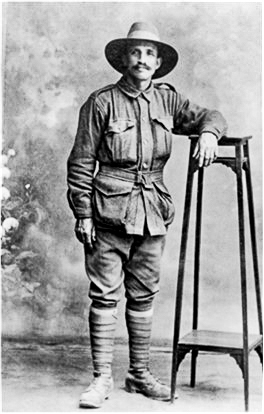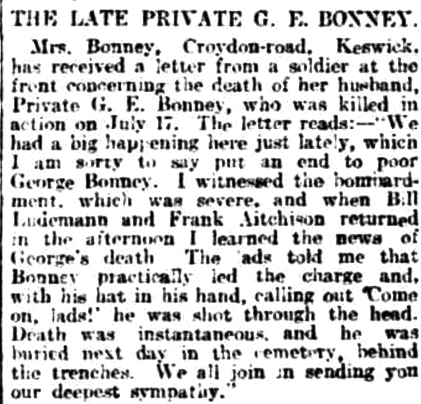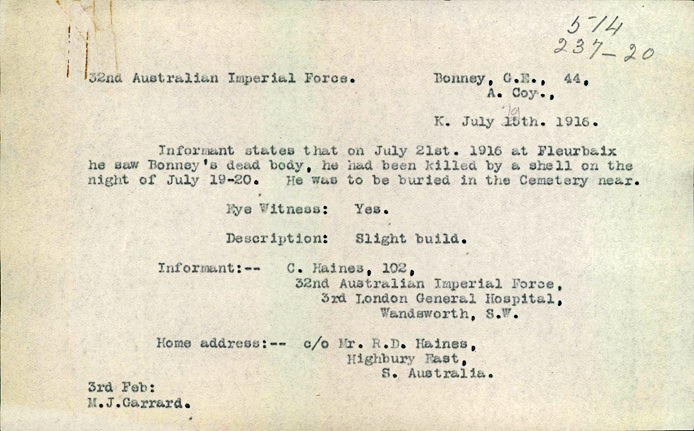George Edward BONNEY
Eyes blue, Hair brown, Complexion fair
George Bonney - “A Genuine Favourite”
Can you help us identify George?
George Bonney was Killed in Action at Fromelles. As part of the 32nd Battalion he was positioned near where the Germans collected soldiers who were later buried at Pheasant Wood. There is a chance he might be identified, but we need help. We are still searching for suitable family DNA donors.
In 2008 a mass grave was found at Fromelles, a grave the Germans dug for 250 (Australian) bodies they recovered after the battle.
If you know anything of contacts in Australia, England or Ireland, please contact the Fromelles Association.
See the DNA box at the end of the story for what we do know about his family.
Early Days
George Edward Bonney was born on August 23, 1876 in Unley, South Australia. He was the second youngest child of William Lambourne and Eliza Johanna (nee Powell) Bonney’s eleven children.
His siblings were:
- William (1853–1912),
- Frances Ellen (1855–1914),
- Albert John (1857–1916),
- James Frederick (1859–1946),
- Edwin Frank (1861–1875),
- Jane Mary (1864–1866),
- Alfred Ernest (1867–1929),
- Arthur Thomas (1869–1894),
- Lily Maud (1874–1954)
- and Charles Henry (1878–1959).
George grew up in Unley, South Australia and attended Parkside Primary School. Unfortunately, his father passed away when George was nine years old. He began working at 13 at the Government Printing Office. He later became a printer’s machinist where it was reported:
“He was thorough in all he undertook, and a genuine favourite.”
He married Florence Mabel Connor on January 24, 1900, in Adelaide, South Australia and they had three children: Percival Harold (1896–1979), Thelma Edris (1900–1972) and Stanley George (1905-1966). George was active in the local community. He was a prominent member of the Richmond Democratic Club, serving as secretary and president at various times. He also had taken a great interest in the Labor Party, working hard for them for many years.
Off to War
Even though he was 39 years old and had three children, George enlisted on 1 July 1915 at Keswick, South Australia. He was assigned to the newly formed 32nd Battalion, A Company. George’s future son-in-law Gordon Mills (143) enlisted on the same day and was also part of the 32nd Battalion. Gordon was wounded in action at Fromelles. He married George’s daughter Thelma in 1920 at St Paul’s church, Adelaide.

The 32nd embarked from Adelaide, South Australia on 18 November 1915 aboard HMAT A2 Geelong, headed for Egypt. They were ‘properly’ farewelled:
“The 32nd Battalion went away with the determination to uphold the newborn prestige of Australian troops, and they were accorded a farewell which reflected the assurance of South Australians that that resolve would be realised.”
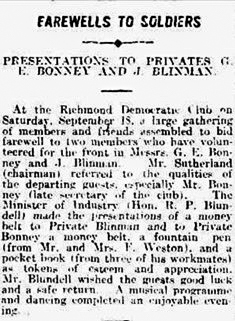
Farewell to John Blinman and George Bonney. John Blinman was attached to the 14th Field Ambulance and won a Military Medal for conspicuous gallantry and devotion to duty near MORLANCOURT, South West of ALBERT on 29th July 1918.
After arriving in Suez on 14 December 1915 they moved to the El Ferdan camp, just before Christmas. A month later they marched to Ismailia, then to the large camp at Tel El Kabir for February and most of March. During their time in Egypt the 32nd did have had the honour of being inspected by H.R.H. Prince of Wales and they greeted him with “enthusiastic cheers”.
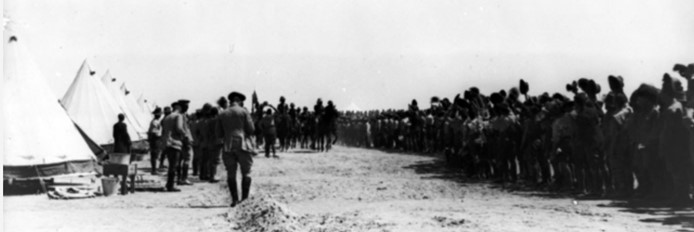
The next stops were at Duntroon Plateau and Ferry Post until the end of May, training and guarding the Suez Canal. Their last posting in Egypt was a few weeks at Moascar.
George was obviously not overly enamoured with his Egyptian experience, writing his family:
”You say you envy me having this trip. Well you are foolish to do this, as the biscuits for one thing we used to get, the least said the better. They look like wooden blocks and I can tell you they felt like it. Nearly all the blokes with false teeth broke their plates.”
”We are in a deadly place now. Terribly hot and no water, only enough to keep you from thirst. If the Torrens river was here it would be worth its weight in gold.“
The call to support the British Expeditionary Force on the Western Front came in mid-June. They left from Alexandria on the ship Transylvania on 17 June 1916 arriving at Marseilles, France on 23 June 1916. They then were put on trains for the two-day trip to Steenbecque, near the Belgian border. Their route took them to a station just out of Paris, within sight of the Eiffel Tower, then through Bologne and Calais, with a view of the Channel before marching to their camp at Morbecque, about 30 kilometres from Fleurbaix.
Fromelles
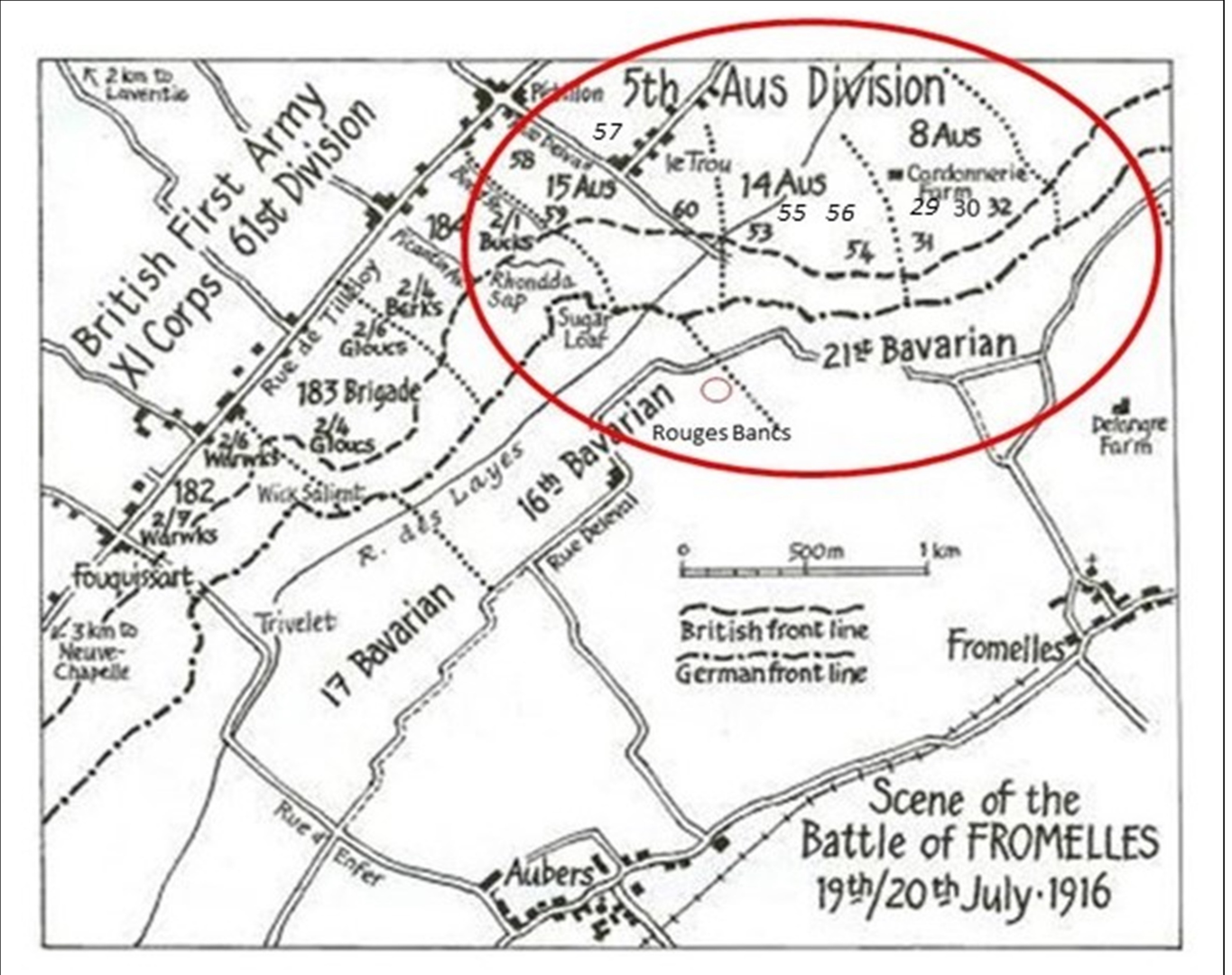
George was moved to the front on 14 July and was into the trenches for the first time on 16 July, a year after he had enlisted. On the 17th they were reconnoitering the trenches and cutting passages through the wires, preparing for an attack, but it was delayed due to the weather. Two days later they made their move. The Australian 8th Brigade, which included the 32nd Battalion, were to cross about 100 metres of No-Man’s-Land and assault the German trenches on the left flank of the Allied attack.
Being on the extreme left flank made their job even more difficult, as, not only did they have to protect themselves from the front, but they also had to block off the Germans on their left while advancing in order to prevent the Germans from coming around behind them. All were in position by 5.45 PM and the charge over the parapet began at 5.53 PM. George’s A Company was in the first of the waves to go and, according to a letter one of his (unnamed) mates sent to George’s wife.
“Bonney practically led the charge, and with his hat in hand, shouted “Come on Lads!”
As brave as he was, George was one of the first killed, near the parapet.
The 32nd were successful in their initial assaults and were in control of the German’s 1st line system by 6.30 PM. Fighting continued through the night, but they were so far advanced that they were getting shelled by both sides and there was machine gun fire from behind and from the emplacement at Delangre Farm. Also, given the advances, their rear trench had been left almost empty, which then enabled the Germans on their flanks to be in a position to surround the soldiers.
When they were forced to retreat, they had to fight their way back to their own lines. What was left of the 32nd had finally withdrawn by 7.30 AM on the 20th. The initial head count was devastating – 71 killed, 375 wounded and 219 missing, including George. To get some perspective of the battle, when Charles Bean, Australia’s official war historian, attended the battlefield two and half years later, he observed a large amount of bones, torn uniforms and Australian kit still on the battlefield.
The final impact was that 225 soldiers of the 32nd Battalion were killed or died from wounds sustained at the battle and of this 166 were unidentified, including George.
Where is George?
A second soldier, Lance Corporal M. Brown (53) supported that George had been killed as he went over the parapet:
“He went over the parapet close to me on the date mentioned at Fromelles and was killed before he had gone more than a few yards. He was one of the 1st men killed. He is buried in the Cemetery at Fromelles and a cross with his name on it is erected over the grave.”
Both the soldier who wrote to George’s wife and Corporal Brown seemed to have actually been with George when he died, but several more “secondhand” reports state that George was killed by a shell.
Private C. Haines’ (102) February 1917:
“Informant states that on July 21st 1916 at Fleurbaix he saw Bonney's dead body, he had been killed by a shell on the night of July 19-20. He was to be buried in the Cemetery near.” Corporal H.W. Furze’s (498) statement was similar.
While how he was killed may not be certain, all of these witness statements do say that George was buried in a cemetery near the battlefield, even mentioning he had a cross for his grave. As he was killed near the Australian lines, it is easy to believe that his body would have been recovered. There also a handwritten mention of “Buried 4971(?)” in his AIF file, but there are no other details records to support that he was, in fact, buried by his mates.
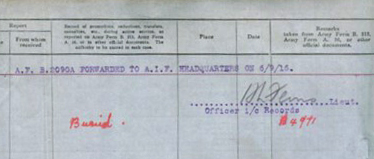
Over 100 years later, George remains “missing”.
Remembering George
George was fondly remembered by his family and friends throughout the years. Multiple memorial notices appeared in local newspapers in the years following his death. He and Gordon had obviously become friends, as Gordon’s memorial notice in 1917 reads:
“I often think of days gone by,
When we roamed the world together -
Now a shadow over our life is cast –
A dear pal gone for ever”
George is commemorated at:
- VC Corner, Fromelles, France
- Australian War Memorial Roll of Honour, Canberra
- Adelaide National War Memorial
- Adelaide Treasury Department WW1 Honour Board
- SA Government Printing Office WW1 Honour Board
- Unley Town Hall WW1 Honour Board
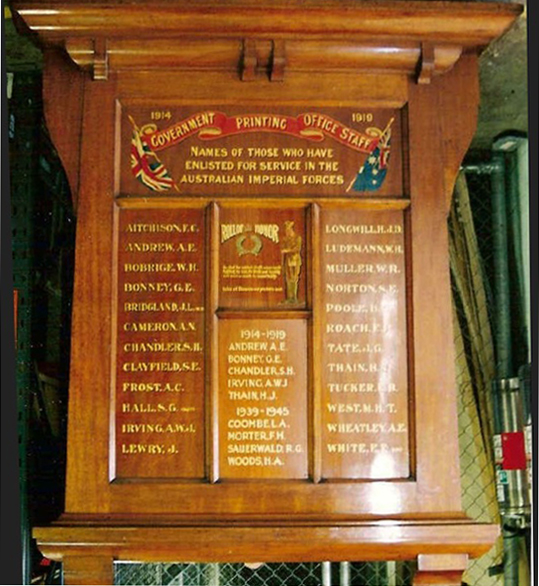
George middle row, second down
Can George still be found?
As of 2024, 41 of the 166 originally unidentified soldiers from the 32nd have been confirmed to be in the German mass grave at Pheasant Wood that was found in 2008. These soldiers have now been given a proper burial and recognition.
There are a further 70 soldiers of the 250 that were in the grave who are as yet unidentified. One of them could be George.
DNA is still being sought for family connections to
| Soldier | George Edward Bonney 1876-1916 at Unley, South Australia |
| Parents | William Lambourne Bonney (1830-1885) and Eliza Johanna Powell (1832-1898), South Australia |
| Siblings | William 1853-1912 | ||
| Frances Ellen (1855–1914) married Charles Brown | |||
| Albert John (1857–1916) married Susannah Beard | |||
| James Frederick (1859–1946) | |||
| Edwin Frank (1861–1875) | |||
| Jane Mary (1864–1866) | |||
| Alfred Ernest (1867–1929) | |||
| Arthur Thomas (1869–1894) | |||
| Lily Maud (1874–1954) | |||
| Charles Henry (1878–1959) |
| Grandparents | |||
| Paternal | James and Elizabeth Bonney, Saffron Walden, Essex | ||
| Maternal | William and Elizabeth Powell, Ireland |
.
Seeking DNA Donors

Contacts
(Contact: royce@fromelles.info or geoffrey@fromelles.info).
(Contact: army.uwc@defence.gov.au or phone 1800 019 090).
Donations
If you are able, please contribute to the upkeep of this resource.
(Contact: bill@fromelles.info ).
